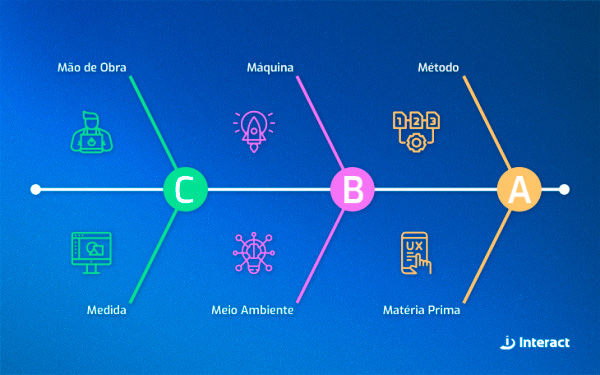
Facing the current market requires smart moves and strategic decision-making from companies. Today, even the smallest of failures can bring serious headaches for managers up front. Therefore, no action can be taken based on “guessing”; measures need to be strengthened with data. And the Ishikawa Diagram is the ideal tool to find errors and visualize quick solutions.
The Ishikawa Diagram is a management tool used to identify failures, provide opportunities for corrections and prevent future occurrences. Created in the 1940s by the Japanese engineer, Kaoru Ishikawa, it aims to identify the main causes of problems so that companies do not waste solutions on secondary causes (Neipatel).
Also called the Fishbone or Cause and Effect Diagram, the diagram has been perfected for use in different segments and businesses. Today, the tool is one of the most remembered in organizations’ quality control and improvement actions, as it helps in the treatment of non-conformities.
The Ishikawa Diagram is even available as an analysis tool within the SA Suite, in the SA Occurrence Manager module and in the components section. In it, it is possible to group and visualize several causes of origin of any problem or of a result that is intended to improve within the routine of the company.
What are the benefits of using Ishikawa?
- Improves understanding of processes
- Improves productivity levels
- Helps to easily find the best solutions to problems
- It is flexible, that is, it adapts to any company and problem.
- Helps keep the team focused on priority solutions
- Improve business vision
How to draw the Ishikawa Diagram?
When referring to the “fishbone” model, it is already possible to imagine how to draw the diagram. Basically, it consists of a central horizontal line, followed by six perpendicular lines. Three at the top and three at the bottom.
Each of these perpendicular lines represents one of the six categories of analysis (the causes), also called the “6 Ms”. At the tip, or “fish head”, the problem (the effect) is described.
When defining the analysis effect, it is questioned how a given cause influences the incidence of the problem and, then, the spaces are completed with the necessary reflections.
In Suite SA, the diagram is already drawn within the system, being only necessary to edit the content of the analysis. Once saved, you can add the template in Presenter SA or attach it to a software bookmark.

What are the 6 Ms of the Ishikawa Diagram?
The 6Ms are six causes/issues related to a problem. When it is identified, just answer the six fields to find out which step needs improvement.
- Method: Processes and procedures used to carry out the work.
- Raw material: Quality of the material used for the production and its suppliers.
- Labor: Performance of employees to perform the work.
- Machine: Equipment and tools used in the process or project.
- Measure: Metrics and indicators used to measure results.
- Environment: Moment of the market, organizational climate of the team
Ishikawa X Non conformities
As we have already explained here on the Interact Blog, incident management is inevitably synonymous with money. This is because having or not controlling non-conformities will define whether the company will go around in circles with palliative measures for problems and occurrences or if it will detect them, correct them and, from that, take off in its strategic planning.
In this context, the Ishikawa Diagram is a tool that only tends to contribute to the treatment of occurrences and non-conformities. Therefore, when talking about Quality Management, Espinha de Peixe immediately stands out among managers. In addition to being simple to use, it is visually attractive and broadens the view of the business.
Interested in finding out more about non-conformities and how to use the tool to your advantage? Download the e-book “Management and registration of Occurrences: Learn how to save time and money with them” using the button below.



